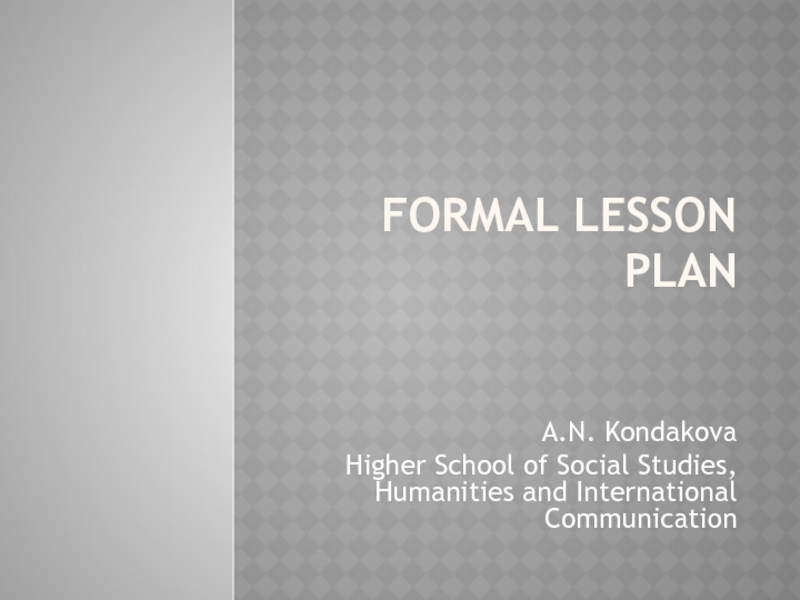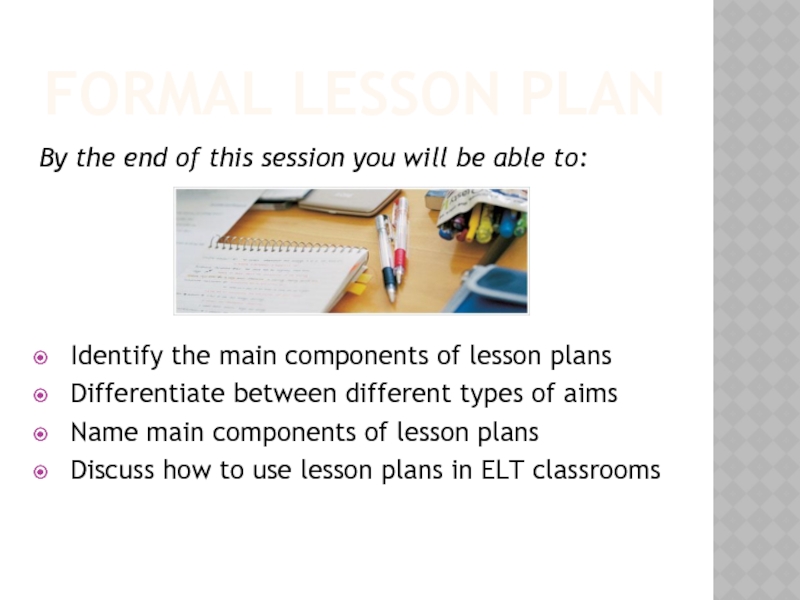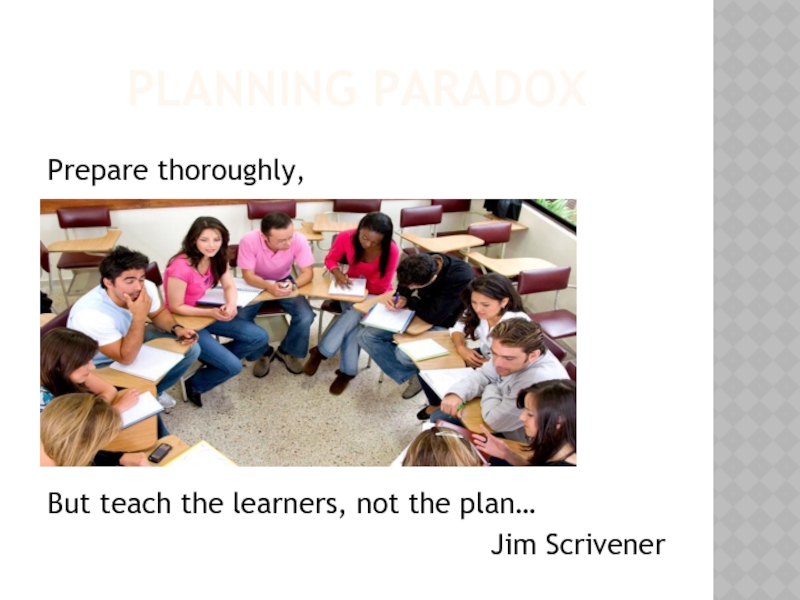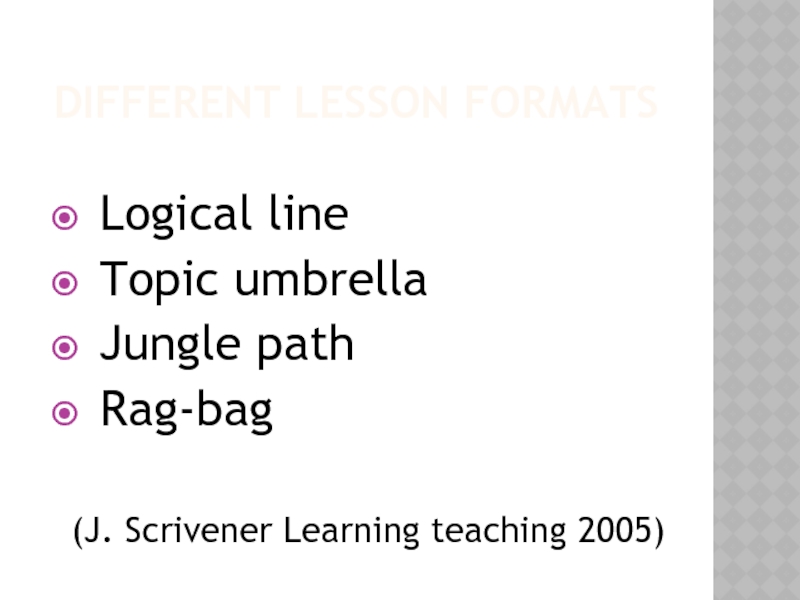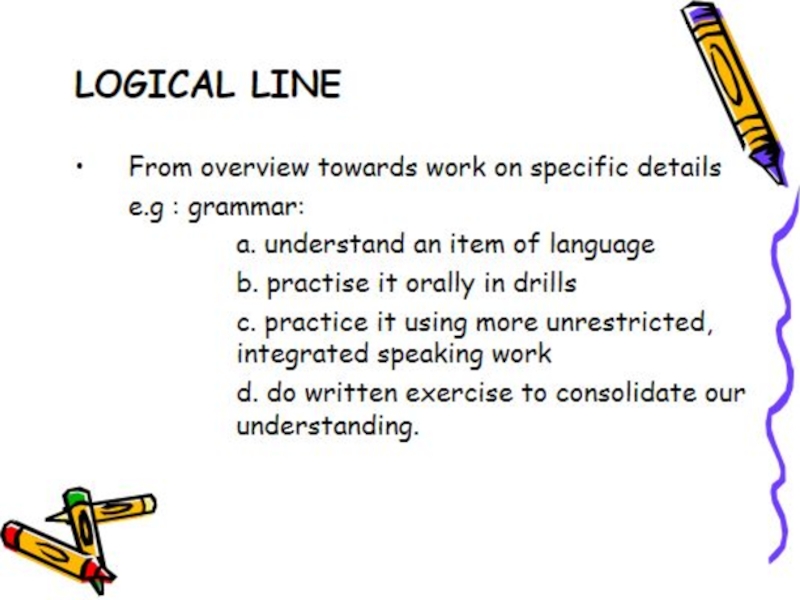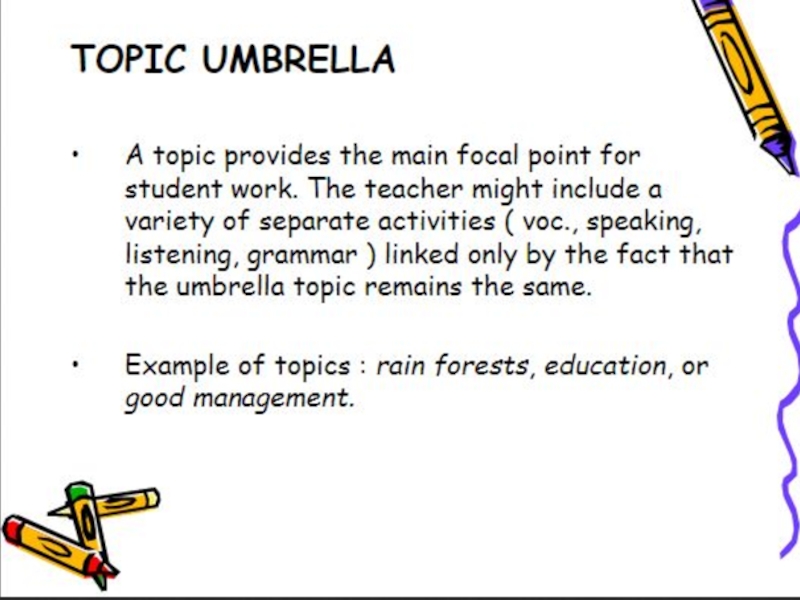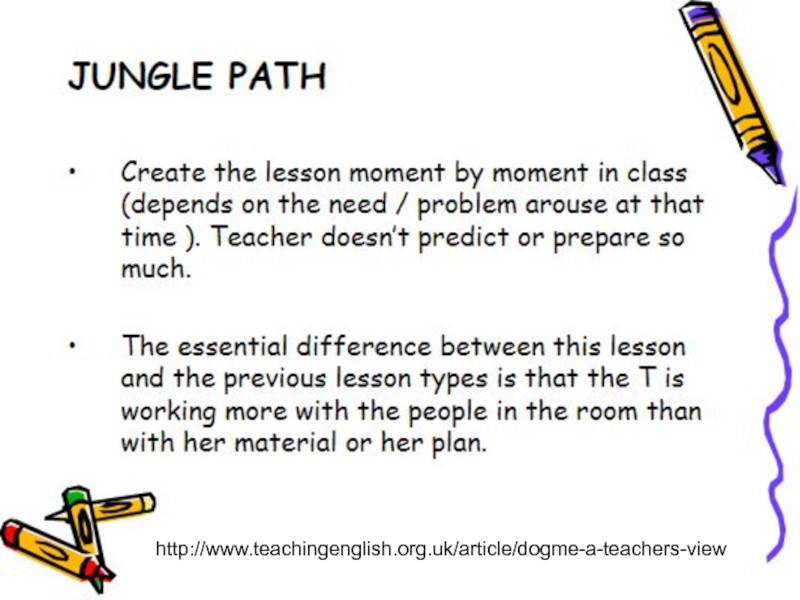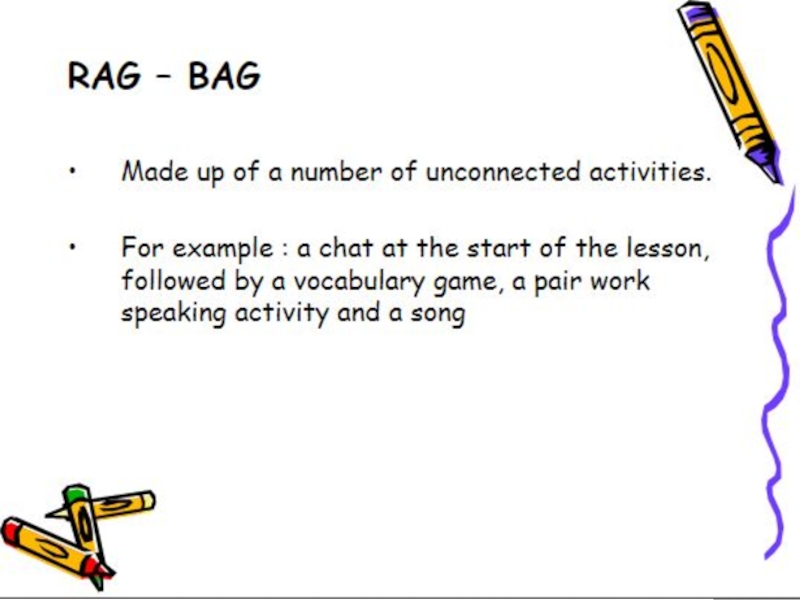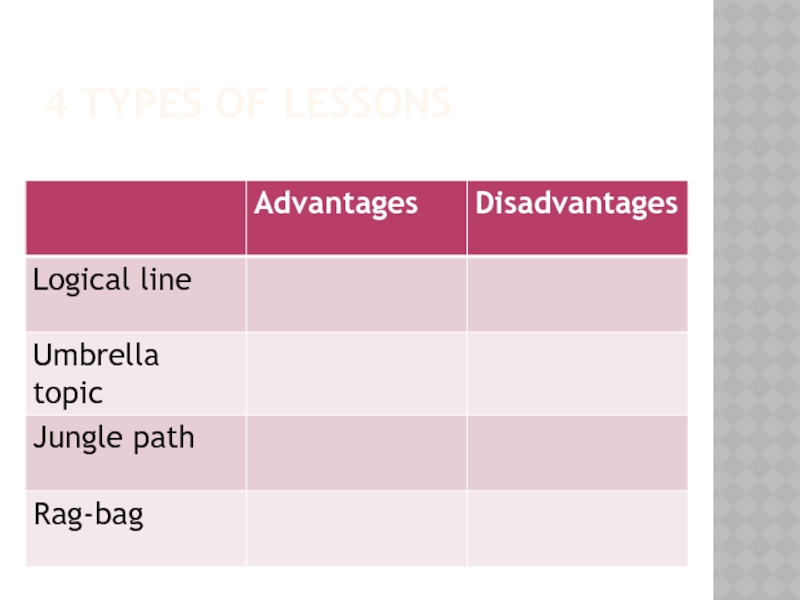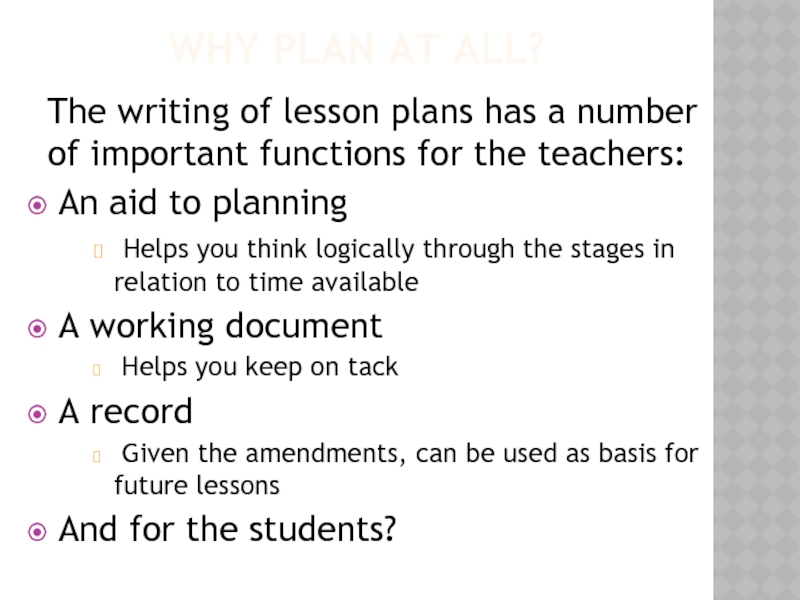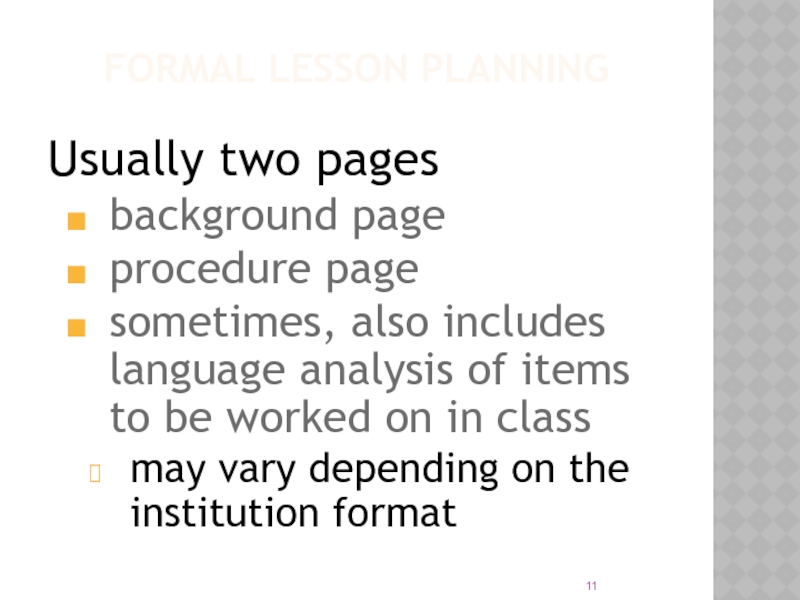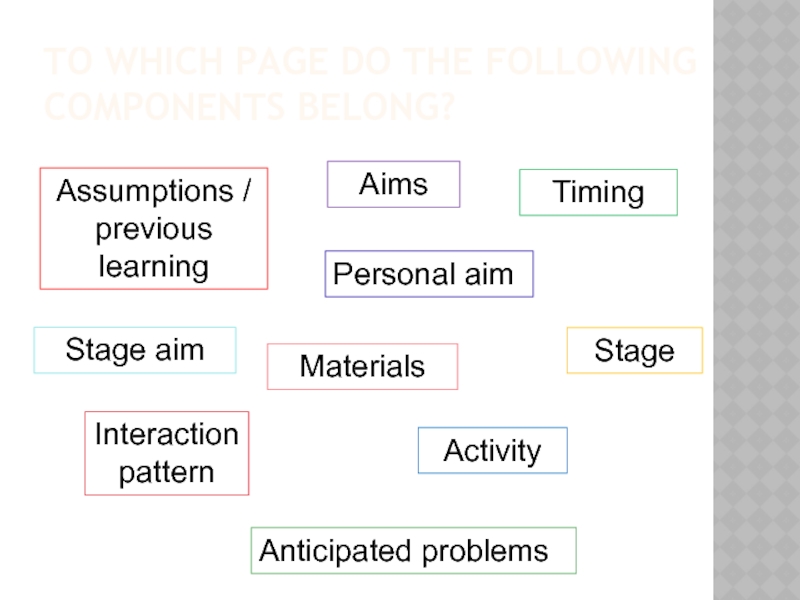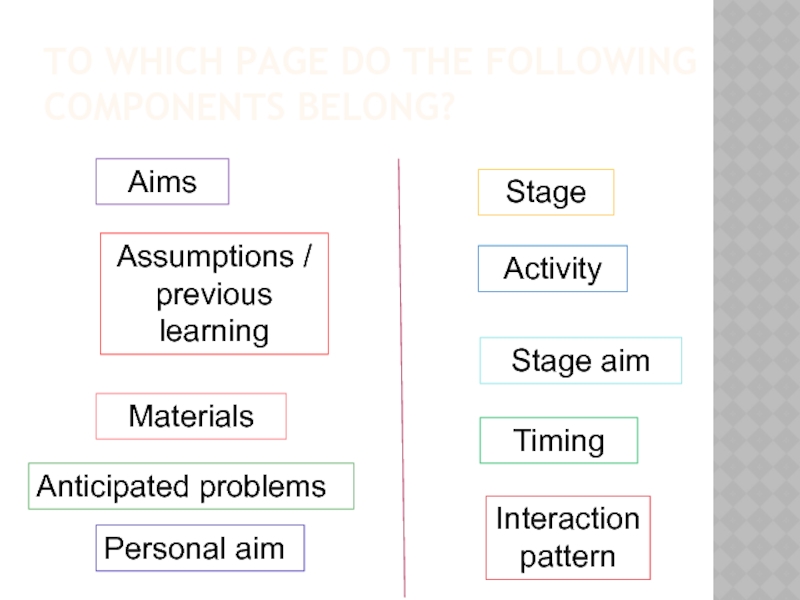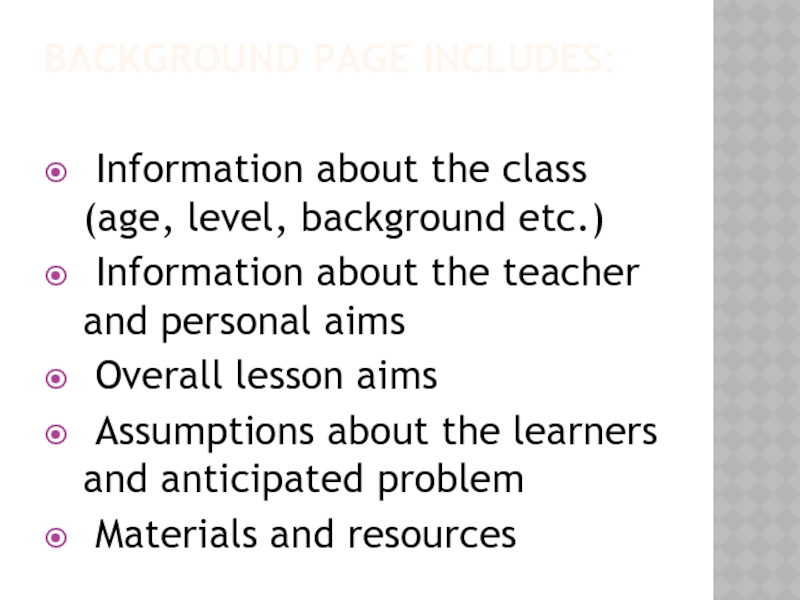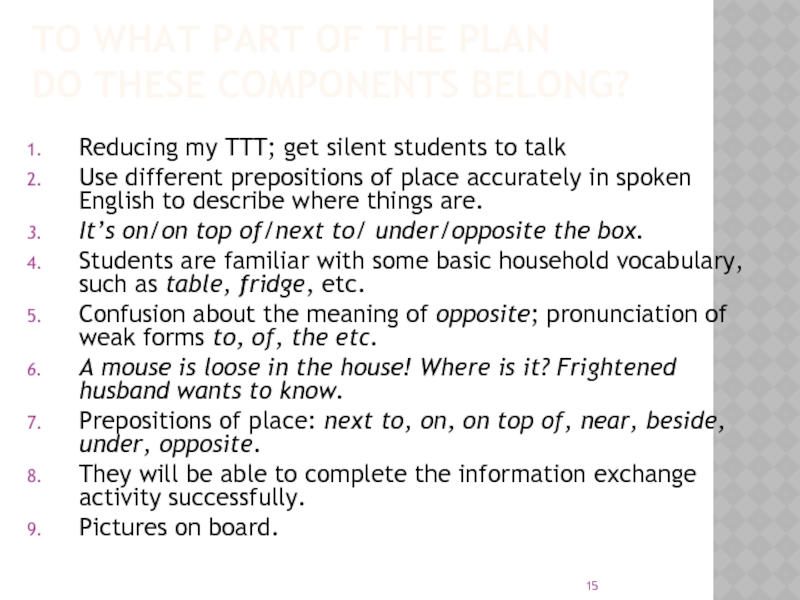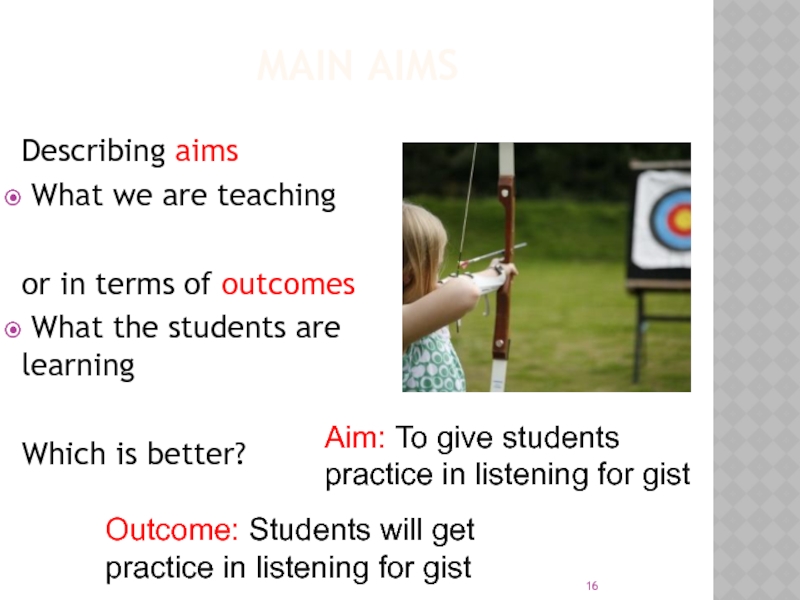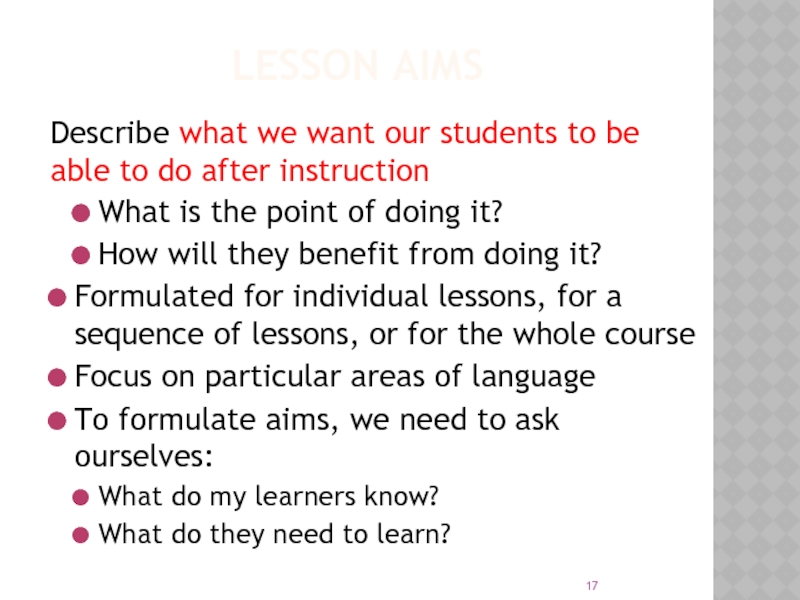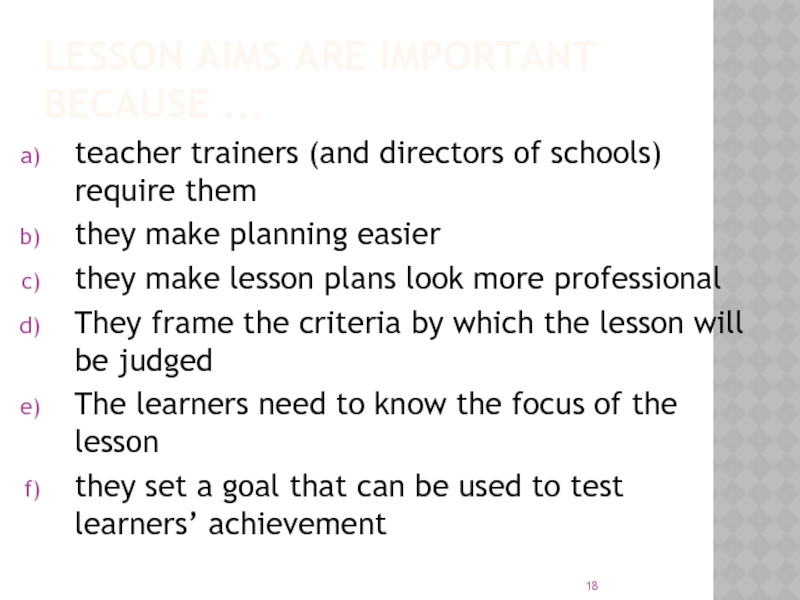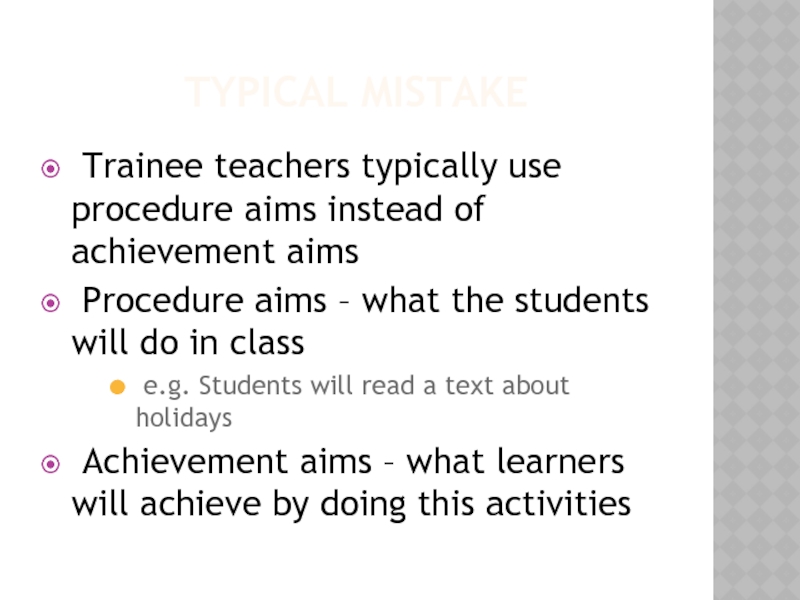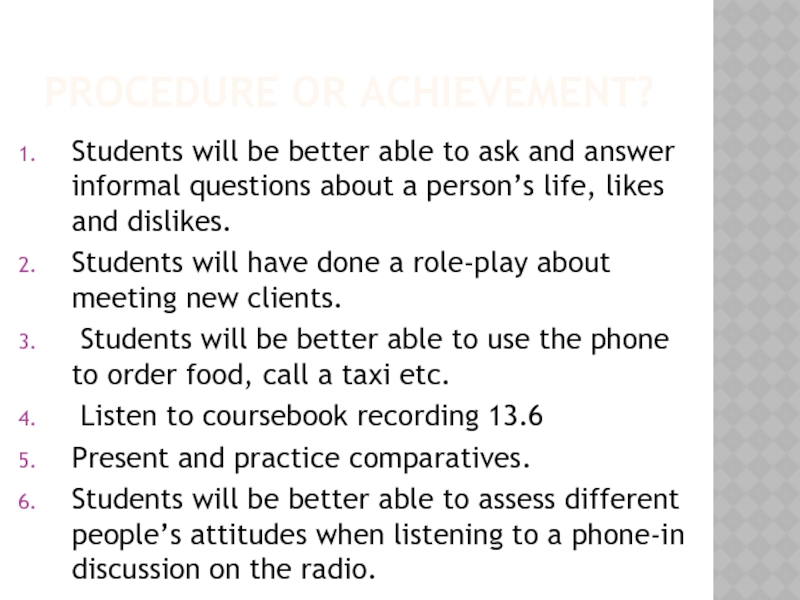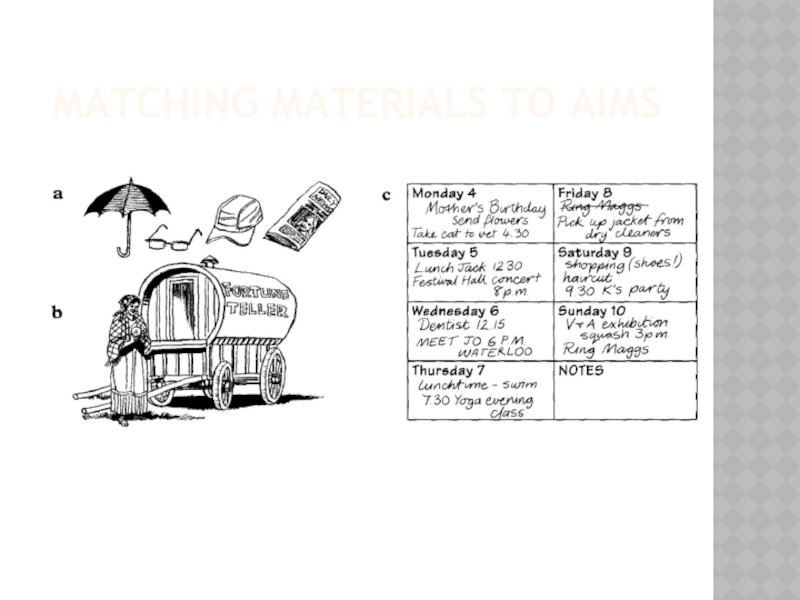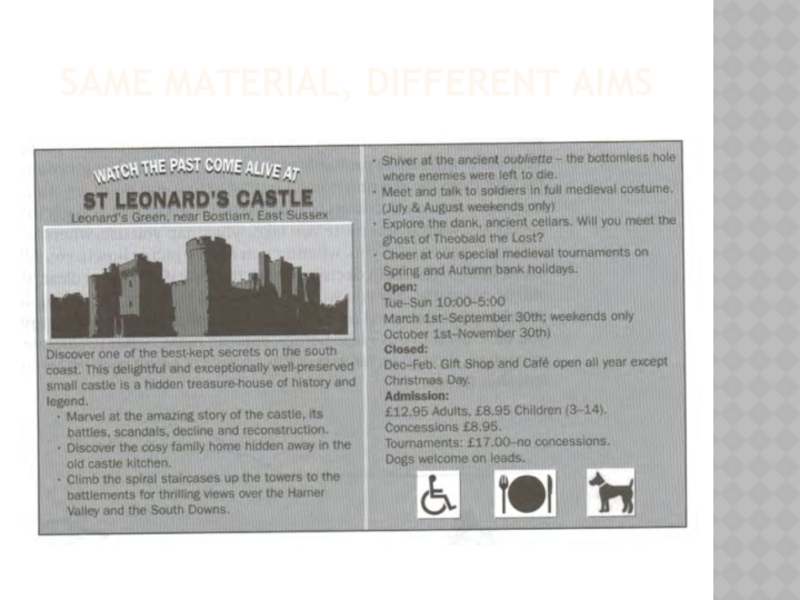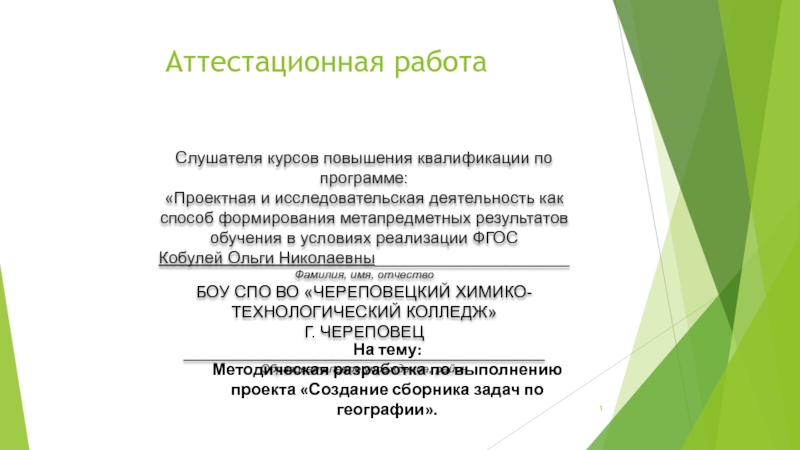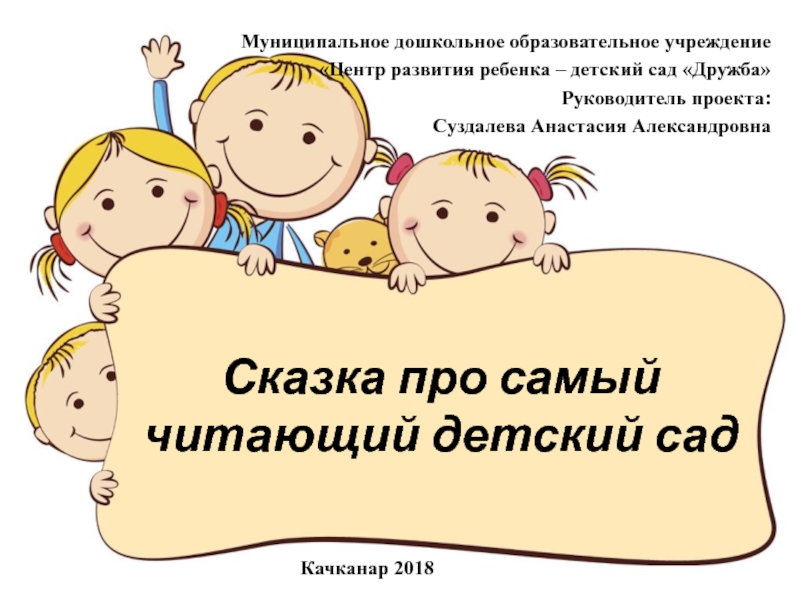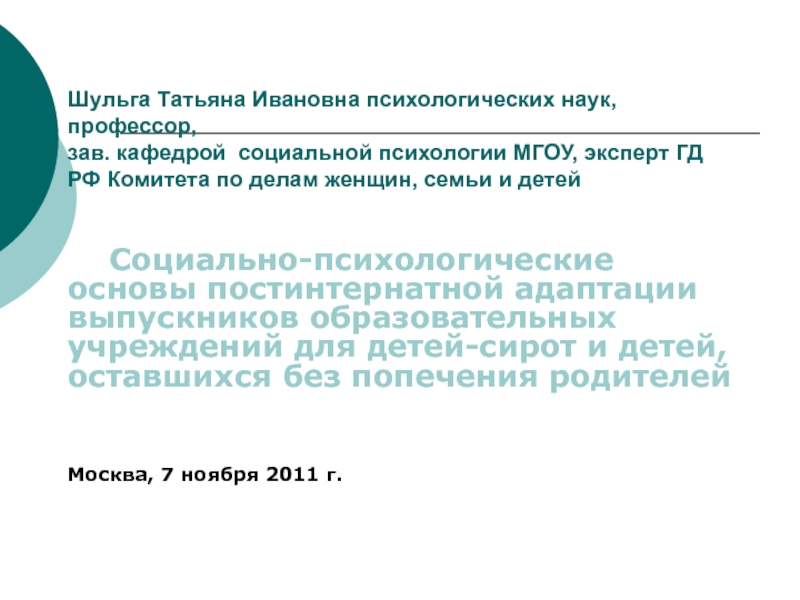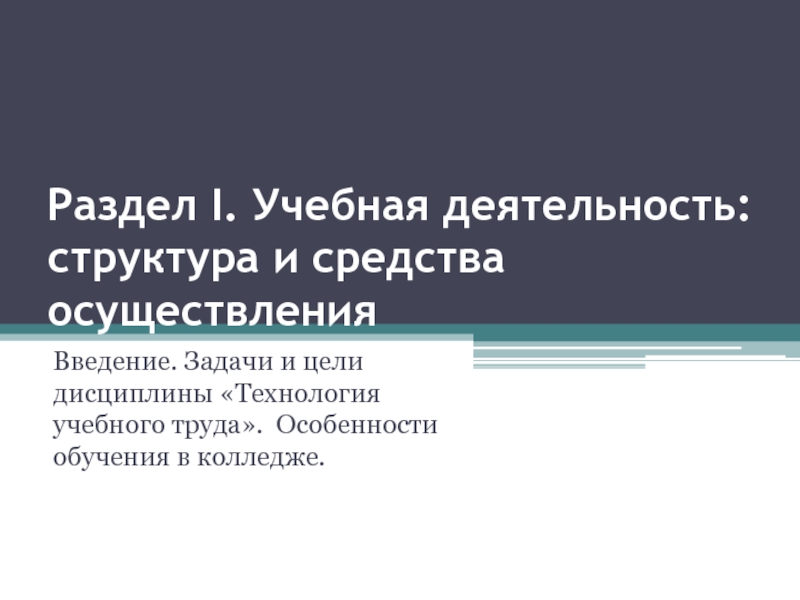- Главная
- Разное
- Дизайн
- Бизнес и предпринимательство
- Аналитика
- Образование
- Развлечения
- Красота и здоровье
- Финансы
- Государство
- Путешествия
- Спорт
- Недвижимость
- Армия
- Графика
- Культурология
- Еда и кулинария
- Лингвистика
- Английский язык
- Астрономия
- Алгебра
- Биология
- География
- Детские презентации
- Информатика
- История
- Литература
- Маркетинг
- Математика
- Медицина
- Менеджмент
- Музыка
- МХК
- Немецкий язык
- ОБЖ
- Обществознание
- Окружающий мир
- Педагогика
- Русский язык
- Технология
- Физика
- Философия
- Химия
- Шаблоны, картинки для презентаций
- Экология
- Экономика
- Юриспруденция
Formal Lesson plan презентация
Содержание
- 1. Formal Lesson plan
- 2. FORMAL LESSON PLAN By the end of
- 3. PLANNING PARADOX Prepare thoroughly,
- 4. DIFFERENT LESSON FORMATS Logical line
- 7. http://www.teachingenglish.org.uk/article/dogme-a-teachers-view
- 9. 4 TYPES OF LESSONS
- 10. WHY PLAN AT ALL? The writing of
- 11. FORMAL LESSON PLANNING Usually two pages background
- 12. TO WHICH PAGE DO THE FOLLOWING COMPONENTS
- 13. TO WHICH PAGE DO THE FOLLOWING COMPONENTS
- 14. BACKGROUND PAGE INCLUDES: Information
- 15. TO WHAT PART OF THE PLAN
- 16. MAIN AIMS Describing aims What
- 17. LESSON AIMS Describe what we want our
- 18. LESSON AIMS ARE IMPORTANT BECAUSE ... teacher
- 19. TYPICAL MISTAKE Trainee teachers typically use
- 20. PROCEDURE OR ACHIEVEMENT? Students will be better
- 21. MATCHING MATERIALS TO AIMS
- 22. SAME MATERIAL, DIFFERENT AIMS
Слайд 1FORMAL LESSON PLAN
A.N. Kondakova
Higher School of Social Studies, Humanities and International
Слайд 2FORMAL LESSON PLAN
By the end of this session you will be
Identify the main components of lesson plans
Differentiate between different types of aims
Name main components of lesson plans
Discuss how to use lesson plans in ELT classrooms
Слайд 4DIFFERENT LESSON FORMATS
Logical line
Topic umbrella
Jungle path
Rag-bag
(J. Scrivener
Слайд 10WHY PLAN AT ALL?
The writing of lesson plans has a number
An aid to planning
Helps you think logically through the stages in relation to time available
A working document
Helps you keep on tack
A record
Given the amendments, can be used as basis for future lessons
And for the students?
Слайд 11FORMAL LESSON PLANNING
Usually two pages
background page
procedure page
sometimes, also includes language analysis
may vary depending on the institution format
Слайд 12TO WHICH PAGE DO THE FOLLOWING COMPONENTS BELONG?
Assumptions / previous learning
Aims
Timing
Stage
Materials
Activity
Stage
Personal aim
Interaction pattern
Anticipated problems
Слайд 13TO WHICH PAGE DO THE FOLLOWING COMPONENTS BELONG?
Assumptions / previous learning
Aims
Timing
Stage
Materials
Activity
Stage
Personal aim
Interaction pattern
Anticipated problems
Слайд 14BACKGROUND PAGE INCLUDES:
Information about the class (age, level, background
Information about the teacher and personal aims
Overall lesson aims
Assumptions about the learners and anticipated problem
Materials and resources
Слайд 15TO WHAT PART OF THE PLAN
DO THESE COMPONENTS BELONG?
Reducing my
Use different prepositions of place accurately in spoken English to describe where things are.
It’s on/on top of/next to/ under/opposite the box.
Students are familiar with some basic household vocabulary, such as table, fridge, etc.
Confusion about the meaning of opposite; pronunciation of weak forms to, of, the etc.
A mouse is loose in the house! Where is it? Frightened husband wants to know.
Prepositions of place: next to, on, on top of, near, beside, under, opposite.
They will be able to complete the information exchange activity successfully.
Pictures on board.
Слайд 16MAIN AIMS
Describing aims
What we are teaching
or in terms of
What the students are learning
Which is better?
Aim: To give students practice in listening for gist
Outcome: Students will get practice in listening for gist
Слайд 17LESSON AIMS
Describe what we want our students to be able to
What is the point of doing it?
How will they benefit from doing it?
Formulated for individual lessons, for a sequence of lessons, or for the whole course
Focus on particular areas of language
To formulate aims, we need to ask ourselves:
What do my learners know?
What do they need to learn?
Слайд 18LESSON AIMS ARE IMPORTANT BECAUSE ...
teacher trainers (and directors of schools)
they make planning easier
they make lesson plans look more professional
They frame the criteria by which the lesson will be judged
The learners need to know the focus of the lesson
they set a goal that can be used to test learners’ achievement
Слайд 19TYPICAL MISTAKE
Trainee teachers typically use procedure aims instead of achievement
Procedure aims – what the students will do in class
e.g. Students will read a text about holidays
Achievement aims – what learners will achieve by doing this activities
Слайд 20PROCEDURE OR ACHIEVEMENT?
Students will be better able to ask and answer
Students will have done a role-play about meeting new clients.
Students will be better able to use the phone to order food, call a taxi etc.
Listen to coursebook recording 13.6
Present and practice comparatives.
Students will be better able to assess different people’s attitudes when listening to a phone-in discussion on the radio.
